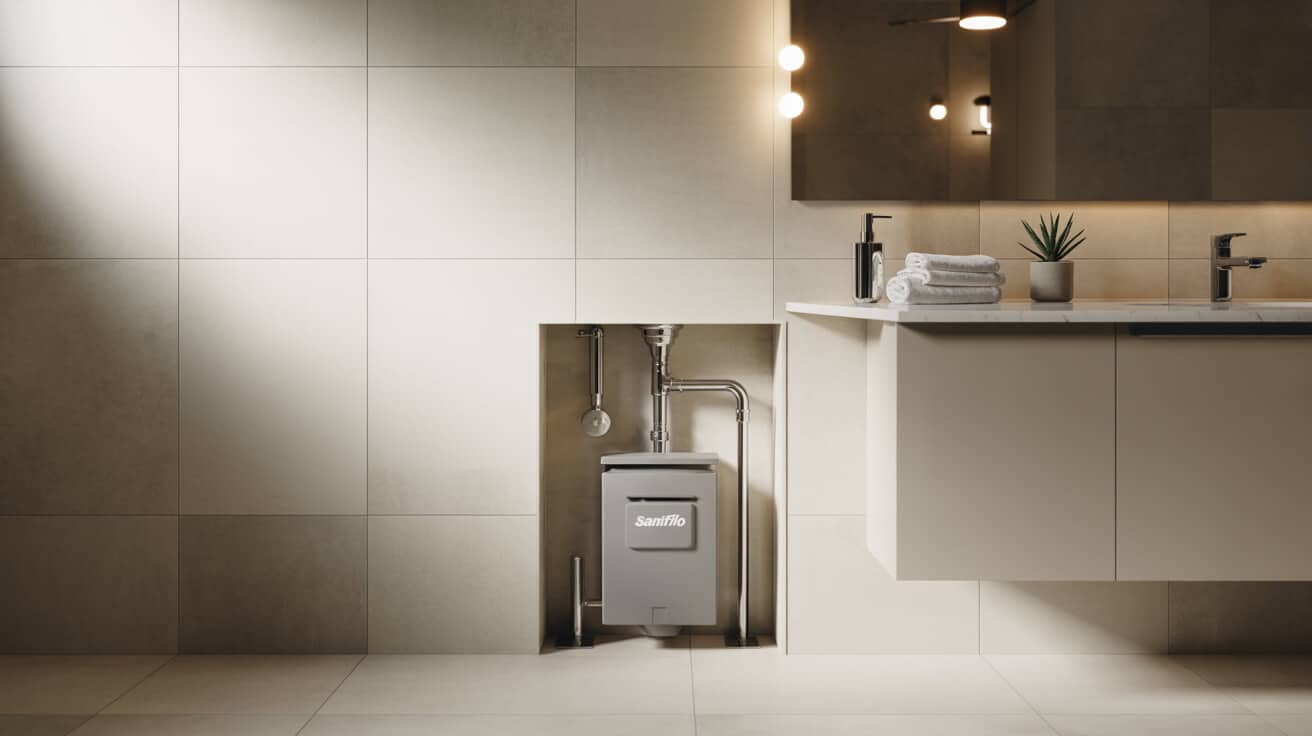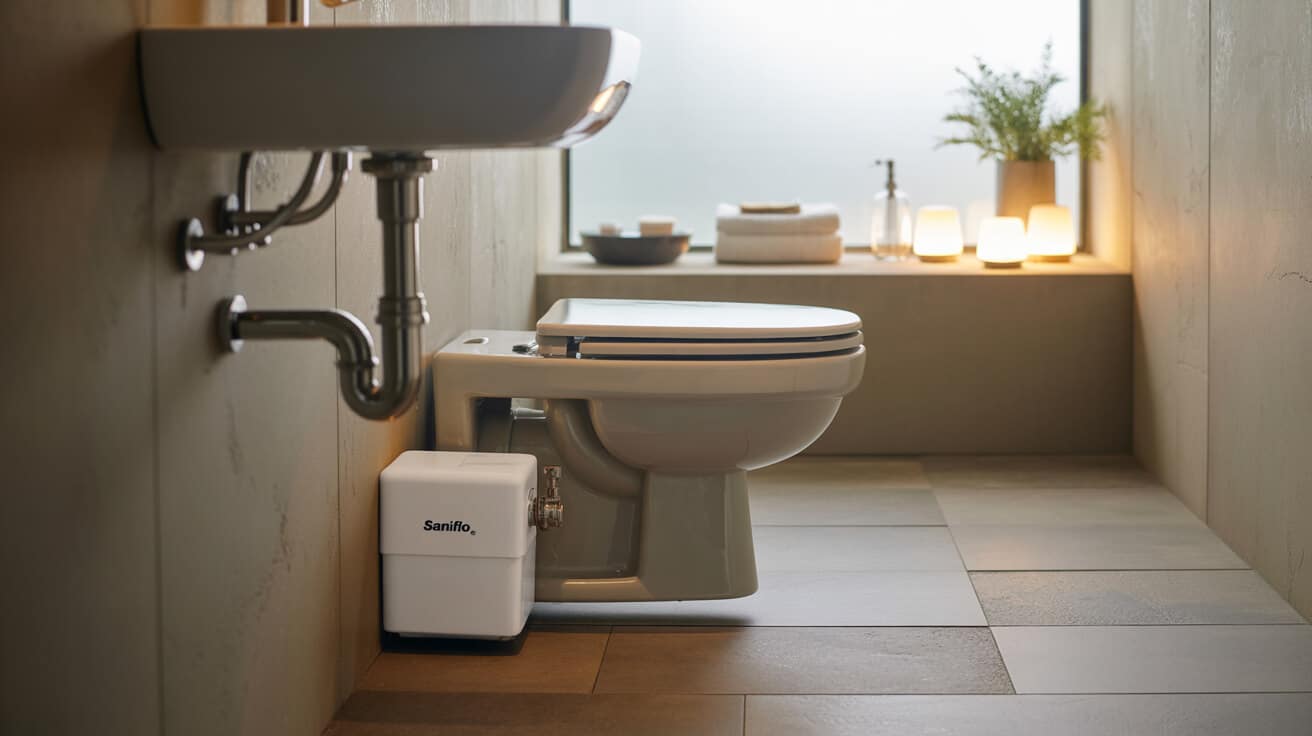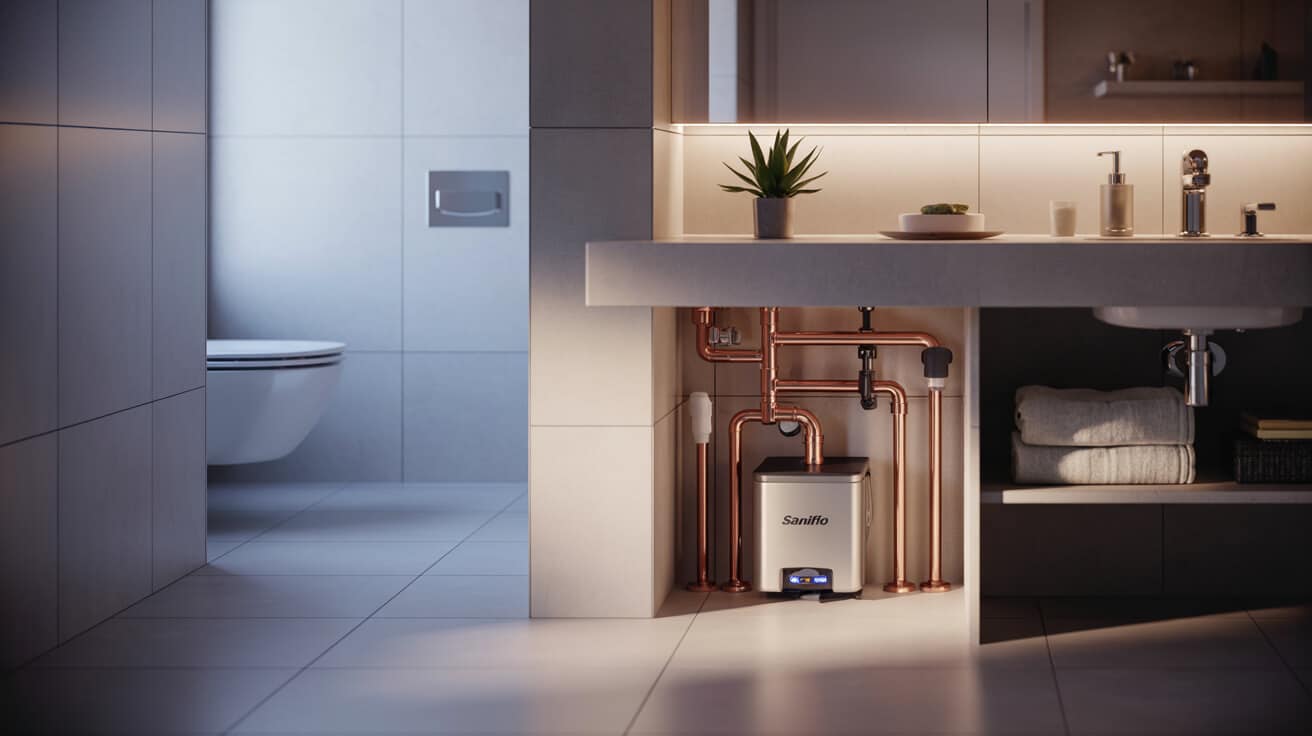Saniflo systems are engineered for environments where conventional plumbing approaches encounter architectural, spatial, or legacy barriers. The installation empowers clients to optimise use of below-ground, attic, or remote annex spaces, expanding bathroom or utility services without the cost or impracticality of redesigning foundational drain lines. The underlying mechanism couples high-torque maceration with pressure-augmented wastewater ejection along small-diameter pipework, achieving compliant and efficient transfer while remaining minimally invasive to existing structures.
From initial surveying through certification, installation adheres to rigorous standards encompassing hydraulic dynamics, electrical safety (including the UK’s Part P protocols), and product-specific warranty obligations. Homeowners, landlords, facility managers, and property investors each benefit from the resulting flexibility, but each faces distinct considerations around compliance, service lifecycle, occupant convenience, and value preservation. Services delivered by Plumbers 4U integrate regulatory assurance, technical clarity, and ongoing support to ensure installations remain robust, code-compliant, and tailored to your needs.
Etymology or name origin
The “Saniflo” brand originated in France in the mid-20th century as an innovation designed to confront the increasing demand for modern sanitation in multistorey buildings where retrofitting gravity drains proved infeasible. Over subsequent decades, the term “Saniflo” expanded beyond its propriety roots, emerging in common parlance across the United Kingdom and parts of Europe as shorthand for pumped macerator systems in general. This linguistic evolution mirrored the growing presence of competing manufacturers, such as SFA Group and Grundfos, whose portfolios contributed to the normalisation of the macerator as a core component of flexible building design and adaptation.
Overview / context
Macerator pumping systems occupy a central role in contemporary plumbing and heating portfolios, supporting essential amenities in basements, attics, outbuildings, and spaces shaped by historical or architectural constraints. The technical solution—harnessing aggressive mechanical fragmentation of waste and active pumping—opened avenues for fitting toilets or wetrooms distant from established stacks or at elevations beneath street sewers.
Adaptive reuse projects, landlord-driven refits, and assisted-living upgrades increasingly rely on these units, as do property developers seeking high occupancy rates from challenging housing stock. In managed estates, their deployment mitigates the need for disruptive, costly interventions into historic structures or high-rise residential towers, while supporting rapid, code-aligned turnarounds between tenancies or commercial lease agreements.
History
Origins
Pumped macerator concepts first appeared in postwar France during a period of urban densification and infrastructure renewal. The initial market responded to the challenges of providing modern WCs in older, multi-storey buildings with limited vertical and horizontal drainage options. Early innovations focused on integrating a compact chamber with rotating cutting blades powered by a synchronous electric motor, designed to transform solid waste into disposable slurry.
Industrial emergence
As UK urbanisation accelerated and housing demand outpaced existing pipework, Saniflo-style solutions gained traction among architects and builders. By the late 1970s, macerator systems became increasingly normalised in the technical handbooks of plumbing engineers. Advancements during this era included the transition from single-toilet to multi-fixture handling, improvements in pump reliability, and reduction of operational noise.
Contemporary evolution
Current Saniflo installations reflect decades of user feedback, standardisation pressure, and environmental scrutiny. Regulatory agencies began codifying minimum performance standards such as BS EN 12050, and energy consumption requirements led to the introduction of high-efficiency pump motors. Industry-wide expectation now includes digital monitoring, predictive maintenance protocols, and product-specific warranty compliance, particularly prominent in the practices of service providers like Plumbers 4U.

Concept / description
A Saniflo system operates by using a motor-driven macerator to break down solid waste and toilet paper, blending it with flushing water to create a manageable slurry. Once the system’s float switch is activated by water inflow, the motor commences a rapid rotation of the impeller blades, effecting the maceration process. The resultant mixture is then pressurised and expelled via small-diameter (typically 22–32 mm) pipework toward the main drainage or sewer line, often at distances or vertical heights unachievable through gravity alone.
Components
- Motor and impeller assembly: Generates the torque required for high-speed maceration and propels the slurry through the discharge pipe.
- Blade mechanism: Cuts solids into particles sufficiently small to prevent blockages.
- Float switch: Engineering trigger for automatic pump activation and deactivation.
- Discharge pipework: Usually narrow-gauge, routed carefully to avoid sharp bends, reduced flow, or airlocks.
- Non-return valve: Prevents re-entry of sewage, ensuring unidirectional flow and hygiene.
- Air admittance valve (where installed): Maintains pressure equilibrium, safeguarding appliance traps from siphonage.
Connected appliances
Saniflo installations connect to standard sanitary wares including toilets, sinks, showers, baths, and, with model-specific restrictions, dishwashers or washing machines. Installation scripts are matched to anticipated use, predicted wastes, and the practicalities of site geometry and occupant patterns, to ensure long-term usability and compliance.
Functionality / purpose / applications
Saniflo systems solve architectural, geographical, or regulatory problems by permitting the placement of waste appliances where gravity drainage is not viable:
- Residential retrofits: Enable cost-effective addition of ensuites, basements, or attic washrooms with minimal structural alterations.
- Commercial adaptations: Support rapid fit-outs in restaurants, retail, hotels, and offices, where flexible site usage is valuable.
- Accessibility upgrades: Allow for installation of level-access WC and wetroom facilities in homes for mobility-impaired occupants, often as part of state-funded adaptations.
- Temporary or modular buildings: Provide essential waste solutions in remote worksites, event venues, and modular/portable units prior to permanent infrastructure.
- Heritage or listed properties: Facilitate essential modification without violating protections on historic structural features.
While providing design freedom, such systems are bounded by model-specific lift heights, run distances, allowable connected loads, and need for routine servicing—factors requiring careful balancing in engineering and cost-benefit analyses.
Classifications / types / variants
Saniflo-type pump systems are classified using four main criteria: waste type, appliance load, mounting configuration, and operational robustness.
- Waste type classification:
- WC-only units: Designed exclusively for macerating toilet waste.
- Greywater units: Accept input from sinks, showers, and appliances with no or minimal solids.
- Combined units: Engineered to handle both blackwater (toilet) and greywater in single or multiple fixtures.
- Appliance load:
- Single-fixture: Supports one appliance, often a WC.
- Multi-fixture: Engineered for three or more appliances, e.g., WC plus basin and shower.
- Mounting configuration:
- Floor-standing: Traditional, accessible for servicing.
- Concealed/behind-pan: Integrated with furniture or wall cavities for space-saving or aesthetic purposes.
- Operational robustness:
- Standard residential: Designed for intermittent personal use.
- Heavy-duty/commercial: Tolerates frequent cycles and high solid loads (public venues, offices, schools).
| Type | Suitable Appliances | Max Vertical Lift (m) | Max Horizontal Run (m) | Example Models |
|---|---|---|---|---|
| WC-only | Toilet | 3 | 30 | Saniflo SFA, Grundfos |
| Greywater | Sink, shower, bath | 2 | 50 | Saniflo Grey, Fluchsan |
| Multi-appliance | WC, basin, shower | 5 | 100 | Saniflo Pro, Grundfos |
| Heavy-duty/commercial | Multiple toilets | 8 | 100 | SFA Sanicubic |
Systems / tools / methodologies
The methodology of Saniflo pump installation follows a sequential, code-anchored workflow:
Tools
- Pipe and cable cutters
- PTFE tape, flexible couplers, solvent cement
- Spirit level and laser alignment aids
- Pressure test kit
- Fused spur tester and RCD trip device
- Marker and calibration sets
Methodology
- Planning and access: Position the unit for optimal appliance connection, adequate maintenance clearance, and shortest possible discharge run.
- Physical installation: Secure chamber to subfloor, apply mounting brackets if suitable, and connect to waste outlets via manufacturer-compliant adapters.
- Pipework configuration: Route discharge pipe at minimum gradient (typically 1:100), with as few bends as design allows, always ascending at required intervals to combat potential syphon effects.
- Electrical setup: Wire in accordance with Part P (UK), employing a fused spur with properly rated RCD and correct IP rating (IPX4 for bathrooms).
- Commissioning: Simulate usage with water and/debris, observe pump activation/deactivation, test for leaks, odour, and abnormal noise.
- Documentation: Issue certificates of installation and compliance, update property asset file or warranty registration, communicate maintenance schedule.
Providers such as Plumbers 4U maintain detailed checklists and service logs at every stage, ensuring continuity in property records and legal documentation.

Stakeholders / entities involved
Homeowners and occupiers
Benefit from the ability to instal modern conveniences, maximise utility in difficult spaces, and achieve increased property value or amenity without extensive building works. Concerns centre on cleanliness, quiet operation, and low-maintenance reliability.
Landlords and property managers
Appreciate the expedited fit-out times, minimised construction, and competitive compliance benefits. Focus is maintained on risk—especially blockages, warranty voidance, and regulatory sign-off.
Facilities directors and commercial clients
Leverage pumping systems to manage high-occupancy, multi-user, or public sanitary facilities, seeking solutions that ensure uptime, efficient cleaning, and minimal disruption in operational schedules.
Plumbing and heating professionals
Execute precise steps in alignment with codes and evolving best practices, balancing demands of architecture, user needs, and topological challenges.
Enforce standards for safety, environmental impact, and consumer protection, with building control inspections for notifiable work and adherence to documentation requirements.
Manufacturers and suppliers
Support clients via product development, maintenance resources, and technical guidance in product selection, ensuring market differentiation by quality and reliability.
Legal / regulatory / ethical considerations
Installation and operation of Saniflo-type pumps fall under a range of regionally- and nationally-mandated standards:
- BS EN 12050: Defines criteria for lifting plants for waste water, including performance, accessibility, and maintainability.
- Building Regulations Part H (UK): Prescribes rules for discharge falls, venting arrangements, and location suitability.
- Part P (Electrical Safety, UK): Lists certified procedure for any electrical connection in humid or splash-prone zones.
- WRAS regulation: Approves use of components and materials in contact with water to prevent contamination risk.
- G3 unvented hot water standards (where heating integration occurs): Additional safety protocols for integration with indirect systems.
With Plumbers 4U, your company receives comprehensive compliance documentation, step-by-step notification support, and assurance of best-practice adherence—protecting not just physical plant, but warranty and insurance status. Failure to meet standards can result in invalidated property insurance, legal censure, or occupant risk, emphasising ethical necessity in installation.
Performance metrics / data / measurements
Flow rates and discharge
- Standard macerator unit: 75–100 litres per minute; WC-only may range lower
- Maximum vertical lift: 3–8 metres (model dependent)
- Horizonal run: Up to 100 metres
- Cycle time: Approximately 10–20 seconds per flush event
Environmental and durability metrics
- Power consumption: 400–700 W per cycle
- Sound level: Manufacturer-published dB(A) spectrum, typically 45–70 dB at 1 metre
- Service life: Documented 7–10 years with correct maintenance and use
Maintenance best practices
- Descaling frequency: Every 6–12 months
- Check cycle: Quarterly visual examination, leak and odour check, operational run
| Metric | Value range | Factors impacting value |
|---|---|---|
| Flow/Discharge rate | 75–120 l/min | Pump power, pipe run, fixture count |
| Lift height | 3–8 m | Appliance type, building geometry, pump model |
| Power consumption | 400–700 W/cycle | Solid to liquid ratio, ambient temperature |
| Noise rating | 45–70 dB(A) | Model, installation quality, pipe insulation |
| Service interval | 6–12 months | Water hardness, household size, usage patterns |
Challenges / barriers / limitations
Operational issues
- Blockages and jams: Appliances must not be misused for sanitary products or foreign objects. Elevated risk without tenant education or landlord checks.
- Noise concerns: In quiet spaces, pump action can be perceptible; recommended insulation, vibration dampeners, and product selection minimise impact.
- Maintenance access: Units concealed behind furniture or walls without access panels precipitate higher remedial costs.
Technical and compliance problems
- Improper gradient or excessive bends: Can cause incomplete evacuation or airlock, damaging pump and risking leaks.
- Non-compliant electricals: Absence of RCD protection or IPX4 rating increases user risk, contravenes code.
- Property limitations: In heritage buildings, legal restrictions may obstruct piping routes, requiring consent from conservation officers.
Social and economic barriers
- Costs may be a deterrent without visible value payoff; though rapid installation and minimal property disturbance often provide countervailing advantages for your organisation.
- Tenancy turnover and user changeover sometimes lead to miscommunication regarding maintenance cycles, stressing the importance of clear asset handover from providers like Plumbers 4U.
Impact / influence / legacy
Saniflo and related pumping installations have transformed approaches to sanitary provision, especially in constrained or complex environments. Advice from industry-leading consultants and service providers has enabled the flexible placement of critical facilities, improving accessibility, marketability, and comfort in a variety of property types.
The cascading effect across the market includes:
- Revitalization of older housing stock through minimally invasive upgrades.
- Increase in rental income and property value for landlords equipped with additional WCs/bathrooms.
- Facilitation of rapid conversion, facilitating adaptive reuse—turning utility closets, garages, or outbuildings into valuable amenities.
- Standardisation of asset management practices in facilities portfolios, bridging gaps between design, compliance, and operational maintenance.
For facilities management and your company, the legacy is flexibility, occupant satisfaction, and resilience of installations that support evolving space needs.
Future directions, cultural relevance, and design discourse
Advancements in pump and blade technology are expected to deliver lower-noise, higher-efficiency, and more compact units. Market pressure for greater energy and water conservation will influence product design and regulatory frameworks, while policy shifts toward greater accessibility may further normalise Saniflo adoption in both new-build and retrofit contexts.
In cultural terms, pumped macerator installations have become emblematic of resourcefulness in the face of architectural inertia, empowering property stakeholders to adapt, modernise, and personalise the built environment. Growing familiarity among property managers, landlords, and you—our client organisations—signals an inflexion point where convenience, compliance, and comfort are no longer trade-offs, but converging standards in modern living and working spaces. The ongoing discourse integrates voices from building science, social policy, and user experience, foreshadowing an era of ever-more integrated, user-centred plumbing solutions.

